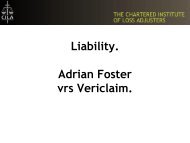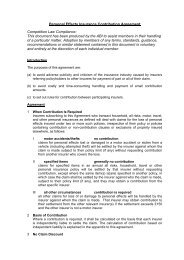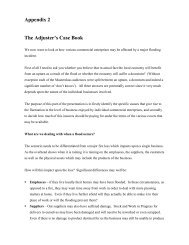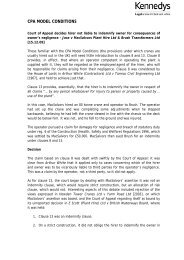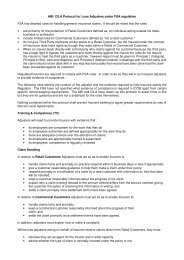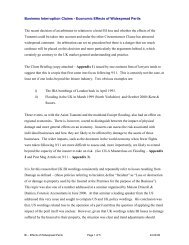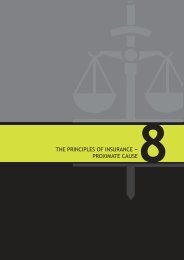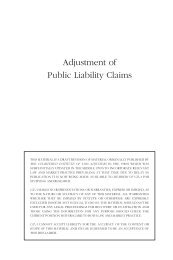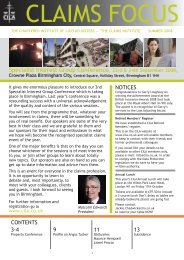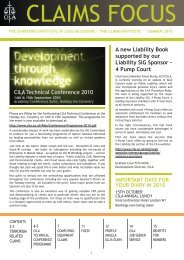Clay Desiccation Demystified - CILA/The Chartered Institute of Loss ...
Clay Desiccation Demystified - CILA/The Chartered Institute of Loss ...
Clay Desiccation Demystified - CILA/The Chartered Institute of Loss ...
Create successful ePaper yourself
Turn your PDF publications into a flip-book with our unique Google optimized e-Paper software.
Context<br />
<strong>Clay</strong> <strong>Desiccation</strong> <strong>Demystified</strong><br />
When a homeowner discovers cracks in his property it is a cause for great concern.<br />
Public knowledge <strong>of</strong> subsidence is now widespread and confirmation that what is<br />
probably your most valuable asset is suffering subsidence damage results in considerable<br />
anxiety.<br />
Subsidence did not always provoke such emotion. Prior to 1971 UK household insurance<br />
policies did not include this peril. This is not to say that buildings did not suffer from<br />
ground movement and consequential fracturing but these seldom resulted in structural<br />
instability and the risk <strong>of</strong> collapse. Fractures would generally open and close seasonally<br />
and filling them in preparation for redecoration was regarded as a normal maintenance<br />
task.<br />
Insurers added subsidence cover to their domestic policies largely at the behest <strong>of</strong><br />
mortgage lenders, believing it exposed them to little additional risk. It was not until the<br />
1975/6 drought that widespread damage resulted in the submission <strong>of</strong> a large number <strong>of</strong><br />
claims. Understandably insurers then became wary <strong>of</strong> <strong>of</strong>fering cover to new<br />
policyholders if their properties exhibited any indications <strong>of</strong> movement whatsoever, i.e. if<br />
they perceived there could be a greater than normal risk.<br />
Valuation surveyors, mindful <strong>of</strong> their exposure to pr<strong>of</strong>essional indemnity claims, reported<br />
all minor fractures regardless <strong>of</strong> whether they considered them to be serious. <strong>The</strong><br />
unintended consequence <strong>of</strong> this was that a house with any cracks was effectively<br />
uninsurable and therefore unmarketable. To enable such properties to be sold without<br />
suffering a diminution in market value (to reflect the cost <strong>of</strong> possible underpinning)<br />
insurers came under pressure to ensure either the cause was removed (this generally<br />
applied to trees whose roots were encroaching beneath the affected foundations) or the<br />
foundations were improved by underpinning. Policyholders would <strong>of</strong>ten remove their<br />
own trees but to get a third party’s tree removed to avoid underpinning, <strong>of</strong>ten requiring<br />
the consent <strong>of</strong> the Local Planning Authority for protected trees or cooperation <strong>of</strong> the<br />
Highways Department, proved very problematic.<br />
If the third party’s tree remained and insurers agreed to meet the cost <strong>of</strong> underpinning,<br />
adjusters were invariably required to seek recoveries from the owners whose trees they<br />
considered responsible for the damage. Liability was rarely conceded and recoveries<br />
were <strong>of</strong>ten based upon superficial technical considerations.<br />
This was the situation that adjusters faced in the late 1970s and early 1980s when Richard<br />
Driscoll published a paper titled “<strong>The</strong> influence <strong>of</strong> vegetation on the swelling and<br />
1
shrinking <strong>of</strong> clay soils in Britain”. This provided an objective measure for “significant<br />
desiccation” and was utilised by adjusters to demonstrate the involvement <strong>of</strong> trees.<br />
How Does Subsidence Differ From Heave And Soil Recovery?<br />
Subsidence refers to downward movement. Heave and recovery are the opposite.<br />
As a tree grows it will abstract moisture from the underlying subsoil and if that medium<br />
is a highly shrinkable, and therefore low permeability, soil it can cause a ‘persistent<br />
moisture deficiency’ to develop . That is, the soil does not fully re-hydrate during the<br />
autumn and winter before it undergoes a further bout <strong>of</strong> clay shrinkage subsidence during<br />
the next growing season.<br />
<strong>The</strong> accumulative subsidence is locked in place until the tree is felled or dies. <strong>The</strong><br />
subsoil will then recover from its desiccated state and if the swelling forces generate<br />
sufficient pressure they will lift a building founded upon that soil. Typically the swelling<br />
pressures generated in London clay as that medium reverts to its equilibrium natural<br />
moisture content will be sufficient to lift a two storey domestic building. Other clays do<br />
not always possess the same ability to ‘bounce back’.<br />
Generally this will result in soil recovery, with the damaged building being lifted back<br />
towards its previous position. This reduces the distortion within the structure, <strong>of</strong>ten<br />
sticking doors and windows again move freely and cracks close. With homeowners<br />
becoming more conscious <strong>of</strong> subsidence problems it is unlikely that persistent moisture<br />
deficits will develop to the extent that recovery will continue for an unacceptable period.<br />
It is important to differentiate between heave and recovery. Heave lifts the affected<br />
foundations to a higher level than where they were constructed. It can take many years<br />
for rehydration to occur, the period principally being dependent upon the degree <strong>of</strong><br />
desiccation and the permeability <strong>of</strong> the clay. However, heave is only a risk when a<br />
building has been erected above soil with a severe moisture deficit and the cause <strong>of</strong> that<br />
deficit has been removed.<br />
<strong>Clay</strong> <strong>Desiccation</strong><br />
In June 1983 Richard Driscoll’s paper, “<strong>The</strong> influence <strong>of</strong> vegetation on the swelling and<br />
shrinking <strong>of</strong> clay soils in Britain”, was published in Geotechnique, a research journal for<br />
geotechnical specialists. It <strong>of</strong>fered “a tentative means <strong>of</strong> determining the likelihood <strong>of</strong><br />
significant desiccation by relating in-situ moisture contents to liquid limits”.<br />
It is important to note that the objective <strong>of</strong> this paper was to help geotechnical engineers<br />
decide if desiccation existed and thus ascertain whether costly foundations were required<br />
2
for new buildings erected on sites from which trees were to be removed or if<br />
underpinning was required to stabilise buildings that had already suffered some heave<br />
damage. Driscoll addressed whether significant desiccation existed at the time <strong>of</strong><br />
sampling and thus “it could be taken to have occurred (developed) when the soil suction<br />
was sufficiently large that on its release a low-rise building could be lifted”. In other<br />
words, the suction by tree roots overcomes the inherent internal negative pore pressure<br />
within the clay and increases this suction beyond equilibrium levels. When the tree is<br />
removed these increased suctions draw in any available water and the clay rehydrates and<br />
swells to its original volume.<br />
Driscoll’s tentative assessment <strong>of</strong> desiccation compared the actual moisture contents <strong>of</strong><br />
high plasticity clays with their liquid and plastic limits. He suggested that if the moisture<br />
content exceeded 50% <strong>of</strong> its liquid limit there was no desiccation. At 50% the onset <strong>of</strong><br />
desiccation occurred and below 40% the soil sample had attained significant desiccation.<br />
Significant desiccation could also be identified if the actual moisture content was less<br />
than the plastic limit plus 2%, although he considered this was a less reliable indicator,<br />
with increasing unreliability for soils with higher plastic limits.<br />
Driscoll’s formula, as it is sometimes referred to, therefore provides a method (but not the<br />
only method) <strong>of</strong> assessing desiccation. In situ shear vanes were available prior to 1983<br />
and various methods <strong>of</strong> assessing soil suctions have been developed since Driscoll’s<br />
paper was published in Geotechnique<br />
Application <strong>of</strong> Driscoll’s “Formula”<br />
At a time when subsidence was a new peril with limited understanding <strong>of</strong> the<br />
mechanisms underlying it, pursuing recovery actions against tree owners was extremely<br />
difficult. <strong>The</strong> tree owners vigorously resisted claims against them and only claims<br />
supported by very good evidence were submitted.<br />
Driscoll’s ‘formula’ was eagerly seized upon as providing the best available supporting<br />
evidence <strong>of</strong> desiccation and hence clay shrinkage subsidence via root action. It appears<br />
that the conclusion that ‘significant’ desiccation according to Driscoll enhanced a<br />
recovery gave rise to the corollary for some that in the absence <strong>of</strong> such desiccation a<br />
recovery could not be pursued, because the nearby tree(s) were not implicated. Although<br />
Driscoll’s formula actually indicates a very high level <strong>of</strong> desiccation, with the passing <strong>of</strong><br />
time some practitioners now mistakenly believe it represents the minimum level <strong>of</strong> pro<strong>of</strong><br />
necessary.<br />
Regrettably it is still misquoted and misreported in some ‘expert’ reports when<br />
considering whether or not a tree has caused subsidence damage. <strong>The</strong> fact that the<br />
formula was only <strong>of</strong>fered for high plasticity clays is frequently overlooked and it is <strong>of</strong>ten<br />
3
erroneously applied to low and intermediate plasticity clay samples. In the BRE Trust<br />
guide Subsidence Damage to Domestic Buildings: A guide to good technical practice<br />
published by IHS BRE Press in 2007, Richard Driscoll and Hilary Skinner warn about the<br />
indiscriminate use <strong>of</strong> 0.4w L. and the publishers have kindly authorised us to include a<br />
relevant extract at the end <strong>of</strong> this paper.<br />
What is <strong>Desiccation</strong>?<br />
<strong>Clay</strong> soil comprises clay mineral particles that are molecularly bonded with water to form<br />
a cohesive material. London clay, by way <strong>of</strong> example, typically contains 50% water by<br />
volume.<br />
A clay subsoil can be considered to behave similarly to jelly. <strong>The</strong> overall volume <strong>of</strong> the<br />
subsoil (or jelly) is largely dependant upon the amount <strong>of</strong> water that is bonded at any<br />
given time to the clay minerals (or gelatine). <strong>The</strong> soil (or jelly) will shrink if water is<br />
removed and then subsequently expand if water is reabsorbed. This expansion ceases<br />
when the clay achieves its former or a new state <strong>of</strong> equilibrium, i.e. when there is no<br />
longer a negative pore pressure to draw additional moisture into the soil. It is important<br />
to appreciate that the solid particles do not shrink. Volume change is totally dependant<br />
upon variation in moisture content.<br />
For a clay subsoil the natural (or equilibrium) moisture content is dependant upon its<br />
geological history. If any water is withdrawn the clay by definition becomes desiccated –<br />
that is drier than in its natural state. It follows that a reduction in moisture content will be<br />
accompanied by clay shrinkage and the soil does not have to attain a state <strong>of</strong> ‘significant<br />
desiccation’ before clay shrinkage commences. Fig. 2 in BRE Digest 240, 1993,<br />
illustrates this.<br />
Although in every day usage desiccation generally refers to the complete removal <strong>of</strong><br />
moisture, e.g. desiccated coconut, when used to describe a clay soil it means the subsoil<br />
has attained a lower moisture content than the soil’s natural/equilibrium moisture content<br />
(Institution <strong>of</strong> Structural Engineers, Subsidence <strong>of</strong> low rise Buildings 2000 and BRE<br />
Digest 412, 1996). Damage will usually be very noticeable in a domestic property that<br />
has suffered differential foundation movement where the clay has attained ‘significant<br />
desiccation’ but the onset <strong>of</strong> property damage will be dependant upon the type <strong>of</strong><br />
construction and thus varies from property to property. Sometimes a 1% moisture<br />
reduction (or less) in a clay subsoil will induce sufficient differential foundation<br />
movement to cause damage. It is not always possible for a laboratory to identify such<br />
small reductions and in some instances the soil may have recovered from its earlier<br />
deficiency prior to sampling.<br />
4
<strong>The</strong> apparent lack <strong>of</strong> desiccation by reference to Driscoll’s formula does not dismiss the<br />
possibility <strong>of</strong> clay shrinkage subsidence damage. BRE Digest 412 states: ‘Clearly, w <<br />
0.4w L should be used only as a rough guide and it is unwise to base an assessment <strong>of</strong><br />
desiccation solely on this criterion, particularly if desiccation is slight.’ <strong>The</strong> evidence<br />
should be considered in the round and Driscoll’s formula should not be regarded as ‘the<br />
Holy Grail!’<br />
Conclusions<br />
This article contends that desiccation and the associated clay shrinkage process occurs<br />
due to any reduction in the clay’s natural moisture content and is not restricted nor<br />
limited to the predefined limits <strong>of</strong> Driscoll’s ‘formula’ . Shear vane results or soil<br />
suctions provide indications <strong>of</strong> desiccation but failure to satisfy such criteria at the time<br />
<strong>of</strong> testing does not preclude the possibility (in many cases the probability) <strong>of</strong> clay<br />
shrinkage subsidence.<br />
Remote boreholes may provide some assistance in identifying the pre-damage moisture<br />
content but in practice these are <strong>of</strong>ten <strong>of</strong> limited value due to variations in plasticity<br />
indices across the site and the moisture deficiency being too small to identify by<br />
comparison. In addition, it is <strong>of</strong>ten difficult to site a sufficiently close remote borehole<br />
that is completely unaffected by vegetation.<br />
Key factors in identifying clay shrinkage subsidence damage are distortion, the associated<br />
pattern <strong>of</strong> damage in the building and the season in which this occured. Such factors<br />
should be considered in conjunction with the subsoil (shrinkable or not), roots (present or<br />
not) and any information provided by monitoring. Significant closing <strong>of</strong> fractures and<br />
increases in level throughout the winter are uniquely peculiar to clay re-hydration<br />
following earlier desiccation but the absence <strong>of</strong> such movement ‘after the event’ does not<br />
dismiss the possibility <strong>of</strong> clay shrinkage subsidence.<br />
<strong>Desiccation</strong> is a process rather than a state with only empirically defined parameters as to<br />
when it becomes significant. It is over simplistic to suggest a clay with a moisture<br />
content <strong>of</strong> 39% <strong>of</strong> its liquid limit has the ability to cause damage whereas moisture losses<br />
between 50% and 40% have no effect. If a reduction in moisture content results in a<br />
degree <strong>of</strong> clay shrinkage, as confirmed by BRE Digest 240, then any moisture loss has<br />
the potential to cause subsidence damage.<br />
At its simplest, subsidence damage occurs when a building is “bent” by differential<br />
foundation movement and the stresses generated during that process exceed the<br />
building’s ability to withstand them. Masonry is very good in compression but cracks<br />
under tension. Provided the crack damage indicates subsidence damage, the fundamental<br />
5
question is ‘What, on the balance <strong>of</strong> probabilities, is the cause <strong>of</strong> the differential<br />
foundation movement beneath that part <strong>of</strong> the building at this time’?<br />
A tick box mentality is no substitute for expert appraisal.<br />
Graham Rex, BSc(Hons), MRICS, F<strong>CILA</strong>, ACII, MCIArb, Cunningham Lindsey<br />
(e-mail:- graham.rex@cl-uk.com Tel 01206 754229)<br />
Richard Thomas, BSc(Hons), C.Eng, MICE, A<strong>CILA</strong>, RTG Expert Services<br />
(e-mail:- rthomas@rtgexpertservices.co.uk Tel 01245 402196)<br />
6
Copyright BRE, reproduced by permission.<br />
Acknowledgement<br />
Following the initial publication <strong>of</strong> this paper we have incorporated some helpful<br />
comments from Richard Driscoll and he now endorses remarks in the paper concerning<br />
the use <strong>of</strong> 0.4 x wL. We thank him for his assistance and IHS BRE Press for permission<br />
7
to append the following extract from Subsidence Damage to Domestic Buildings: A guide<br />
to good technical practice published in June 2007, reference FB13, and available from<br />
www.ihsbrepress.com.<br />
Using Moisture Content and Soil Plasticity Measurements<br />
Moisture content may be reliably measured in disturbed soil samples taken from trial pits<br />
(BRE Digest 381) or boreholes; samples must be carefully sealed prior to transporting<br />
and testing in the laboratory or the results can lead to pessimistic assessments <strong>of</strong><br />
desiccation. This potential error and the difficulty <strong>of</strong> determining in a single pr<strong>of</strong>ile what<br />
is the normal moisture content are reduced by comparing moisture content values in<br />
samples taken at the suspect location and at a control location remote from it and the<br />
suspect tree; however, such control measurements are <strong>of</strong>ten difficult to make owing to<br />
the restrictions <strong>of</strong> many urban sites. <strong>The</strong>re is <strong>of</strong>ten reluctance to pay for this more reliable<br />
comparison.<br />
An objection to the use <strong>of</strong> moisture content pr<strong>of</strong>iles to assess desiccation is that, in highly<br />
plastic clays such as London <strong>Clay</strong>, large changes in soil moisture suction occur with only<br />
relatively small changes in soil moisture content, making desiccation detection unreliable<br />
when moisture content deficits are small, even when the deficit is detectable by reference<br />
to a control pr<strong>of</strong>ile. Some people claim to be able to detect desiccation from a difference<br />
between the measured moisture content and a 'natural' value for saturated clay. <strong>The</strong>se<br />
claims should be treated with caution as the 'natural' moisture content, even for a well<br />
known soil such as London <strong>Clay</strong>, can vary quite appreciably from place-to-place,<br />
depending on a variety <strong>of</strong> factors including plasticity and density.<br />
<strong>The</strong> difficulties and costs <strong>of</strong> comparative measurement have led to attempts to identify<br />
desiccation by comparing sample moisture content with some arbitrary value that is<br />
deemed to indicate desiccation. Such an approach, based on shrinkage curves for a<br />
number <strong>of</strong> UK overconsolidated clays (ref to Driscoll, 1983), suggested a relationship<br />
between moisture content, w, and Liquid Limit, wL, at different suction values. <strong>The</strong><br />
relationship suggested that the onset <strong>of</strong> desiccation could be defined as a suction <strong>of</strong> 10<br />
kPa at which pressure many <strong>of</strong> the clay samples tested exhibited a moisture content <strong>of</strong> w<br />
8
= 0.5 wL. <strong>The</strong> relationship further suggested that significant desiccation (defined as a<br />
suction <strong>of</strong> 100 kPa) occurred where w = 0.4 wL.<br />
Largely because <strong>of</strong> its simplicity, this method is <strong>of</strong>ten given unwarranted authority when<br />
assessing suction and establishing tree causation; its indiscriminate use can lead to the<br />
mistaken belief that desiccation is present ( ‘mistaken desiccation’). Particularly, the<br />
method takes no account <strong>of</strong> the stress regime <strong>of</strong> the soil before it was sampled, and can<br />
also give erroneous results in other than high plasticity soil and where the plasticity<br />
varies locally. Consequently, it is now generally considered that this approach should not<br />
be primarily relied upon to indicate desiccation. However, it can provide additional<br />
confirmation <strong>of</strong> desiccation when comparing moisture content pr<strong>of</strong>iles at the suspect site<br />
and at the control site.<br />
9



